Space Telescope
From Hubble to the James Webb Space Telescope, this is the latest on the groundbreaking images our greatest observatories capture each day.
Latest in Space Telescope

Deep Space
From Hubble to the James Webb Space Telescope, this is the latest on the groundbreaking images our greatest observatories capture each day.
Breakthroughs, discoveries, and DIY tips sent every weekday.
By signing up you agree to our Terms of Service and Privacy Policy.